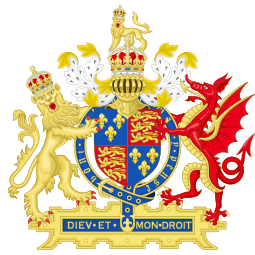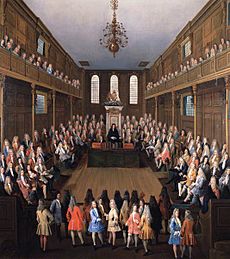House of Commons of England facts for kids
Quick facts for kids The Honourable the Commons of the Kingdom of England in Parliament assembled |
|
|---|---|

Royal coat of arms of England (1509-1554) with English lion and Welsh dragon
|
|
| Type | |
| Type | |
| History | |
| Established | 1341 |
| Disbanded | 1 May 1707 |
| Preceded by | Parliament of England |
| Succeeded by | House of Commons of Great Britain |
| Elections | |
| First past the post with limited suffrage | |
| Meeting place | |
| Various, but usually at the Palace of Westminster | |
| Footnotes | |
| See also: House of Commons of Great Britain |
|
The House of Commons of England was an important part of the Parliament of England. It was like the "lower house" of Parliament. This means it was one of two main groups that helped rule England. It started in the 1300s and included Wales.
In 1707, England and Scotland joined together. The House of Commons of England was then replaced. A new group called the House of Commons of Great Britain took its place. Later, in 1801, Great Britain and Ireland united. This led to another change, creating the House of Commons of the United Kingdom.
Contents
How the English Parliament Began
The Parliament of England grew from an older group called the Magnum Concilium. This was a big council that gave advice to the English king or queen in the Middle Ages. This royal council met for short times. It included church leaders, noblemen, and representatives from different areas. These representatives were known as "knights of the shire".
The council's main job was to approve taxes the King wanted. But often, the council asked the King to fix problems for the people first. Only then would they vote on taxes. This is how the council slowly gained power to make laws.
Early Representatives in Parliament
The first Parliament to invite representatives from major towns was Montfort's Parliament in 1265. Later, at the "Model Parliament" of 1295, representatives from towns and cities were also allowed to join. It became a common rule that each county would send two knights. Also, each town or city would send two "burgesses".
At first, the burgesses had very little power. The King could choose which towns could send representatives. If burgesses tried to be too independent, their towns might be left out of Parliament. The knights of the shire had more power. But they were still less powerful than the nobles and church leaders in Parliament. At this time, Parliament was still one single group.
Growing Independence of the Commons
The Parliament of England split into two separate groups during the rule of King Edward III. In 1341, the Commons met by themselves for the first time. They were separate from the nobility and church leaders. This created two parts: an Upper Chamber and a Lower Chamber. The knights and burgesses sat in the Lower Chamber.
This Lower Chamber became known as the House of Commons. The church leaders and nobility became the House of Lords. Even though the Commons were still less powerful than the King and the Lords, they started to act more boldly.
The Speaker's Role and Early Challenges
During the Good Parliament of 1376, the Commons chose Sir Peter de la Mare. His job was to tell the Lords about their complaints. They complained about high taxes. They also wanted to know how the King was spending money. They even criticized how the King managed the army.
The Commons also tried to remove some of the King's ministers from office. This process is called impeachment. Sir Peter de la Mare was put in prison for his actions. But people saw the benefit of having one person speak for the Commons. This led to the creation of the Speaker of the House of Commons role. Sir Peter de la Mare was released after King Edward III died. In 1377, he became the second Speaker of the Commons.
Under the next king, Richard II, the Commons again tried to impeach royal ministers. They also started to insist that they should control taxes and public spending. Despite these gains, the Commons were still much less powerful than the Lords and the King.
Changes Under the Tudors and Stuarts
The power of the King grew stronger after the civil wars in the late 1400s. These wars weakened the powerful noble families. Both parts of Parliament had little power during these years. The King's absolute power was restored. The King's control grew even more under the Tudor family in the early 1500s. This was because King Henry VII became financially independent.
The English Reformation Parliament, called by Henry VIII, made many laws. These laws affected all parts of national life, especially religious matters. Even though Parliament acted under the King's direction, it gained more power. It became responsible for all matters affecting the country.
When the House of Stuart came to the English throne in 1603, the King again needed Parliament for money. This caused problems. The first two Stuart kings, James I and Charles I, often argued with the Commons. They disagreed about taxes, religion, and the King's powers.
The English Civil War and Parliament's Power
The disagreements between Charles I and Parliament were very serious. They led to the English Civil War. In this war, Parliament's army won. In December 1648, the House of Commons was changed by the army. This event, called Pride's Purge, was the only time the military took control of Parliament in English history.
After this, the King's rule was ended, and the Upper House (House of Lords) was removed. The Parliament that remained was later called the Rump Parliament. It was a small group of members approved by the army. In 1653, this Parliament was dissolved by Oliver Cromwell.
However, the monarchy and the House of Lords were both brought back in 1660. The King's power had been reduced. It was further lessened after James II was removed from power in the Glorious Revolution of 1688. This led to the creation of the Bill of Rights 1689. This important document set limits on the King's power and gave more rights to Parliament.


